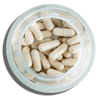p16INK4a is a key marker of aging and cellular health. It increases with age, contributing to cellular senescence, which can lead to age-related diseases. Diet plays a critical role in regulating p16INK4a expression and slowing cellular aging. Here’s what you need to know:
- Caloric Restriction (CR): CR reduces p16INK4a levels, supports cellular repair, and extends lifespan in cells and animals.
- High-Fat Diets: These increase inflammation and p16INK4a, accelerating aging and tissue damage.
- Mediterranean Diet: Rich in olive oil, fruits, vegetables, and fish, it lowers inflammation and supports healthy aging.
- Key Nutrients: Omega-3s, polyphenols (like those in green tea and dark chocolate), and compounds like resveratrol can reduce oxidative stress and influence p16INK4a expression.
Quick Tip: Combining calorie control, nutrient-rich foods, and supplements like NMN or resveratrol can help manage aging at the cellular level.
Longevity on Your Plate: The Role of Diet in Aging and Healthspan with Dr. Cristal M. Hill, USC

How Diet Affects p16INK4a Expression
Diet plays a key role in shaping p16INK4a expression by influencing oxidative stress, inflammation, and metabolic signaling. These factors, in turn, can either speed up or slow down cellular aging. Research highlights how dietary patterns impact p16INK4a through these interconnected pathways.
Effects of Caloric Restriction and High-Fat Diets
Caloric restriction (CR) has been shown to affect p16INK4a expression through several mechanisms. For instance, studies on aged rats revealed that CR prevents hypermethylation at critical E2F-1 binding sites, maintaining better cellular function as they age[4]. Similarly, research on human lung fibroblasts found that glucose restriction extended cell lifespan by as much as 67%, promoting weeks of healthier functioning[5]. CR also activates SIRT1 and modifies chromatin structure, leading to reduced p16INK4a expression[5].
On the other hand, high-fat diets have been linked to increased inflammation and pain signaling, both of which accelerate aging processes[3]. Interestingly, short-term caloric restriction in obese individuals has been shown to induce DNA methylation changes in genes related to inflammation and lipid metabolism[4]. These findings highlight the contrasting effects of dietary extremes and the importance of precise nutrient strategies.
How Specific Nutrients Modify p16INK4a
Beyond general dietary patterns, specific nutrients can fine-tune p16INK4a regulation. Certain compounds directly impact cellular aging. For example, plant polyphenols - found in foods like berries, green tea, and dark chocolate - help modulate gene expression and reduce oxidative stress, contributing to healthier aging[6]. Similarly, omega-3 polyunsaturated fatty acids, especially those derived from marine sources, are associated with a lower risk of premature death and have been shown to slow cellular aging by preserving telomere length in immune cells[6].
The relationship between omega-3s and p16INK4a expression is particularly intriguing. In one randomized, double-blind, placebo-controlled trial, participants with type 2 diabetes who took 2.4 g of DHA-enriched fish oil daily for 8 weeks experienced increased p16 mRNA levels while showing reduced telomerase activity in their peripheral blood mononuclear cells[8]. This suggests that omega-3s may help remove senescent cells rather than merely prevent their formation.
Vitamin D also plays a role in cellular aging by regulating immune function and inflammation. Although its direct effects on p16INK4a expression need further study, its involvement in these pathways hints at a potential indirect influence on cellular senescence[6].
These findings underscore the combined power of nutrients, as seen in the Mediterranean diet, which amplifies anti-aging benefits through a synergistic approach. Timing and dosage also matter significantly, as demonstrated by the precise outcomes in the omega-3 study[8].
Dietary Patterns and Nutrients That Affect p16INK4a
Building on earlier findings about nutrients, specific dietary patterns work together to influence p16INK4a expression. These patterns often target aging pathways more effectively than isolated nutrients. One standout example is the Mediterranean diet.
Mediterranean Diet and p16INK4a
The Mediterranean diet is widely recognized for its role in promoting healthy aging. Traditionally followed in regions like Greece, Spain, and Italy before the globalization of food systems, this diet has been linked to improved health outcomes during aging[10]. A meta-analysis involving over 1.5 million participants revealed that for every 2-point increase in adherence to the Mediterranean diet, there was a 10% reduction in overall mortality[10]. This reduced risk of death may be tied to the diet’s ability to influence key aging pathways, including those involving p16INK4a expression.
What makes the Mediterranean diet so effective? Its nutrient-rich profile helps lower inflammation and influences gene expression, protecting against genomic changes that drive cellular aging[9]. Key components of this diet include olive oil, vegetables, fruits, legumes, bread, potatoes, nuts, and seeds. Moderate amounts of fish and poultry are also part of the diet, while red meat and sweets are consumed sparingly. Additionally, moderate wine consumption with meals is a hallmark of this dietary approach[9]. Studies have also associated adherence to the Mediterranean diet with reduced levels of 8-oxodG, a marker of oxidative DNA damage linked to genomic instability and cellular aging[12].
Bioactive Compounds for Cellular Aging
Beyond dietary patterns, certain bioactive compounds offer targeted benefits for cellular aging. While diets like the Mediterranean diet provide broad health advantages, these compounds fine-tune the regulation of p16INK4a by affecting DNA methylation, histone deacetylation, and telomerase activity.
For instance, epigallocatechin-3-gallate (EGCG), found in green tea, is a powerful inhibitor of DNA methyltransferase (DNMT), which helps regulate gene expression tied to aging[11]. Research highlights EGCG’s potential in areas such as breast cancer prevention and improved cardiac function[7]. Similarly, sulforaphane, derived from cruciferous vegetables, influences DNMT expression, targeting abnormally methylated genes that contribute to cellular dysfunction[7]. Another compound, resveratrol, found in red grapes, activates sirtuin 1 (SIRT1), a protein that deacetylates histones and plays a role in aging pathways. Resveratrol has shown promise in contexts like breast cancer, renal cell carcinoma, and colorectal cancer prevention[7].
The following table outlines how specific bioactive compounds target mechanisms related to cellular aging:
| Mechanism | Bioactive Component | Target Conditions |
|---|---|---|
| DNA methyltransferase inhibition | Epigallocatechin-3-gallate | Breast cancer, diabetic kidney disease |
| DNA methyltransferase inhibition | Sulforaphane | Breast cancer, cardiomyopathy |
| Histone deacetylase inhibition | Resveratrol | Breast cancer, renal cell carcinoma, colorectal cancer |
| Histone deacetylase inhibition | Gallic acid | Prostate cancer, cardiovascular diseases |
| Telomerase inhibition | Epigallocatechin-3-gallate | Glioblastoma |
MASI Longevity Science offers anti-aging supplements like NMN, Resveratrol, Fisetin, and Spermidine. These products are formulated in Germany and independently tested in Switzerland to ensure their safety, purity, and effectiveness.
These compounds work together to enhance cellular health and support heart and brain function. With over 352,000 members in its global longevity community, MASI provides a science-driven approach to incorporating anti-aging strategies. Combining a nutrient-rich diet like the Mediterranean diet with targeted bioactive compounds offers a powerful way to influence p16INK4a expression and promote healthier aging at the cellular level.
sbb-itb-4f17e23
How Dietary Changes to p16INK4a Affect Cell Function
Adjusting diet can influence the expression of p16INK4a, a key factor in cellular health and tissue performance. Below are some examples showcasing how dietary strategies can benefit specific tissues.
Effects on Different Tissues During Aging
Dietary approaches aimed at regulating p16INK4a expression show promise in addressing age-related issues in various organs. For instance, caloric restriction has been shown to significantly reduce the presence of senescent cells in the liver, white adipose tissue, pancreas, and kidneys within just 8 weeks [1].
The pancreas is particularly sensitive to dietary changes. In mice, removing cells that express p16INK4a reversed a 27% glucose increase caused by a high-fat diet, pointing to improved pancreatic function through reduced p16INK4a levels [16].
Adipose tissue also benefits from dietary interventions. Restricting calorie intake not only decreases the size of fat cells but also reduces markers of aging, such as DNA damage, p21, and IL-6 expression [15]. Additionally, studies on aging mice found that 44% of those treated to eliminate p16INK4a-expressing cells showed increased beta-cell proliferation, which supports tissue regeneration [16].
The liver is another organ that responds well to dietary adjustments. High-fat diets are linked to increased p16INK4a expression, which contributes to fat buildup and the progression of fatty liver disease [2]. However, caloric restriction can counter these effects by lowering age-related gene expression, including p16INK4a, and improving liver function [13].
Skin health is also influenced by diet. High-fat diets have been associated with an overexpression of p16INK4a, leading to inflammation and premature aging. Research on ApoE knockout mice revealed that such diets caused skin thinning, epidermal thickening, hair follicle loss, and early graying [14].
These organ-specific benefits highlight the potential of dietary strategies to influence cellular processes and improve overall tissue health.
Research Summary: Diet and Cellular Renewal
Research underscores how dietary changes can support cellular renewal by regulating p16INK4a expression. For example, glucose restriction has been shown to extend the lifespan of human fibroblasts by 23–67% by reducing p16INK4a transcription over time. In contrast, normal glucose conditions allow the gene product to accumulate gradually [13].
In cases where fibroblasts experienced the greatest lifespan extension (66.7%), scientists observed higher SIRT1 activity and its increased binding to the p16INK4a promoter. This suggests that SIRT1 regulation, driven by caloric restriction, plays a major role in extending cellular lifespan [13].
A 30–40% caloric restriction in rodents has also been shown to decrease markers of senescence and the senescence-associated secretory phenotype (SASP), helping to preserve tissue function and promote healthier aging [12].
The table below summarizes key findings from studies on dietary interventions and their impact on cellular health:
| Dietary Intervention | Tissue/Cell Type | Key Finding | Improvement |
|---|---|---|---|
| Glucose restriction | Human fibroblasts | Extended cellular lifespan | 23–67% increase |
| Caloric restriction | Multiple organs | Reduced senescent cell burden | Significant in 8 weeks |
| p16 cell removal | Pancreatic beta-cells | Improved glucose metabolism | 27% glucose reduction |
| Dietary restriction | Adipose tissue | Reduced cell size and aging markers | Multiple markers improved |
Interestingly, overexpression of p16INK4a has been found to speed up cellular aging in glucose-restricted fibroblasts compared to cells in normal glucose conditions. This highlights the critical role of p16INK4a in the benefits seen from caloric restriction [13]. Additionally, epigenetic changes, such as shifts in chromatin markers, become more evident in later stages of cellular aging, emphasizing the importance of metabolic adjustments through p16INK4a suppression as cells grow older [13].
These findings suggest that dietary strategies targeting p16INK4a expression can promote cellular renewal and help maintain organ function over time. This research lays the groundwork for creating dietary plans aimed at supporting healthier aging.
Dietary Strategies for Healthy Aging
Diet plays a powerful role in influencing p16INK4a levels, a key marker of cellular aging. Research shows that caloric restriction can lower p16INK4a levels and extend the lifespan of cells, making it a promising strategy for healthy aging [17].
In laboratory studies, reducing calorie intake by 30% has been shown to not only extend lifespans but also decrease markers of cellular aging, partly by suppressing p16INK4a expression [17]. However, it’s not just about the calories - it’s also about the balance of macronutrients.
The Role of Macronutrients
Tweaking macronutrient ratios can have a profound impact on aging. For instance, high-protein diets - where protein exceeds 20% of total calories - have been linked to a 75% increase in all-cause mortality and a staggering 400% rise in cancer risk [6]. On the other hand, diets that are lower in protein but higher in carbohydrates seem to promote healthier aging patterns. This suggests that moderation in protein intake could be an important factor in supporting longevity.
Key Nutrients for Cellular Health
Certain nutrients also play a pivotal role in maintaining cellular health. For example:
- Omega-3 fatty acids: Known for their anti-inflammatory properties, they can help combat age-related inflammation.
- Vitamins D and E: These vitamins may influence cellular processes tied to aging [6].
- Zinc: While adequate zinc is essential, too much of it may actually accelerate aging [1].
The Mediterranean diet serves as an excellent model for incorporating these principles. Its plant-based, nutrient-rich focus aligns well with strategies for promoting cellular health [6][12].
Supplements to Support Aging
MASI Longevity Science offers supplements designed to complement these dietary strategies. Their formulations, including NMN, Resveratrol, Fisetin, and Spermidine, target specific aging pathways to enhance cellular vitality. NMN, in particular, plays a critical role in maintaining energy production at the cellular level:
"NMN may improve adult human metabolism, rendering it more like that of someone ten or twenty years younger."
– Shin-ichiro Imai [18]
Practical Tips for Cellular Health
To support cellular health, consider these strategies:
- Eat moderately and reduce saturated fats.
- Increase omega-3 intake and ensure sufficient vitamins and minerals.
- Try intermittent fasting to encourage cellular rejuvenation [17].
As research advances, we can expect more tailored dietary guidelines to emerge. For now, the evidence strongly supports targeted nutritional changes - combined with high-quality supplements - as a proactive way to promote cellular health and longevity.
FAQs
How does caloric restriction affect p16INK4a expression and support cellular health?
Caloric restriction (CR) has been found to reduce the expression of p16INK4a, a key indicator of cellular aging and senescence. By minimizing oxidative stress and cellular damage - two primary drivers of senescence - CR helps slow the buildup of aging cells. This can lead to healthier cell function and potentially extend lifespan.
Pairing CR with a well-balanced, nutrient-dense diet can amplify these effects. Such a diet provides the necessary nutrients to support cellular repair and renewal processes. The connection between p16INK4a and aging underscores how dietary and lifestyle choices can play a powerful role in shaping long-term health and well-being.
How do omega-3 fatty acids and other nutrients impact p16INK4a expression and support healthy aging?
Omega-3 fatty acids, particularly EPA and DHA, play a key role in promoting healthy aging by influencing cellular processes connected to p16INK4a expression. Studies indicate that these nutrients can help minimize DNA damage, decrease cellular aging (senescence), and maintain redox balance - all of which are essential for slowing down the natural decline of cells as we age.
Beyond omega-3s, other important nutrients, such as specific vitamins and dietary compounds, also interact with pathways tied to p16INK4a. By influencing these pathways, they help reduce cellular aging and encourage cellular renewal, which supports overall energy and may help manage age-related health challenges. Including these nutrients in your daily diet could be an effective way to promote healthier aging.
How can I follow the Mediterranean diet to support healthy aging and reduce p16INK4a levels?
To bring the Mediterranean diet into your daily life and promote healthy aging, center your meals around plant-based foods, healthy fats, and meals rich in antioxidants. Aim to include plenty of fruits, vegetables, whole grains, legumes, and extra virgin olive oil. These ingredients are known to help reduce oxidative stress and slow down cellular aging.
When it comes to protein, go for lean options like fish, nuts, and seeds. These not only support cellular health but may also help reduce inflammation. Pairing this diet with regular physical activity can amplify its benefits, influencing key molecular pathways, such as p16INK4a expression, which plays a role in aging.
To stay consistent, consider following a structured plan, like a 7-day or 30-day Mediterranean diet. This approach can make it simpler to stick with these habits and prioritize long-term well-being.




